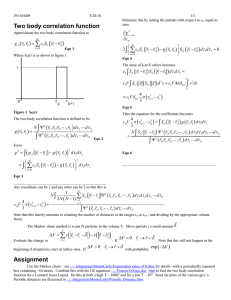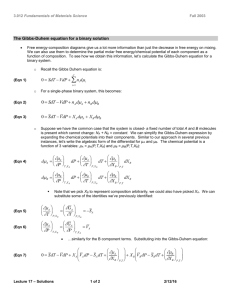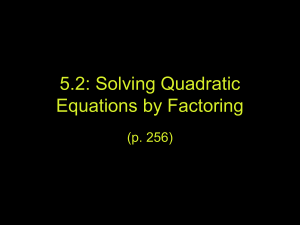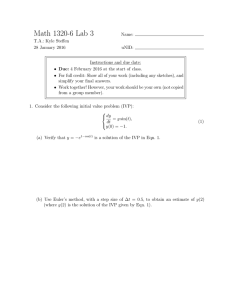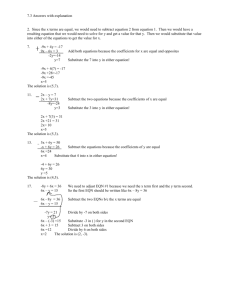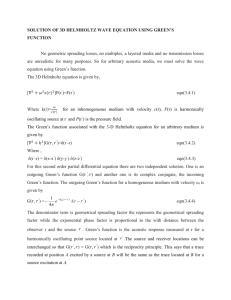COUPLING AND ANOMALOUS TURBULENCE 1981 D.J.
advertisement
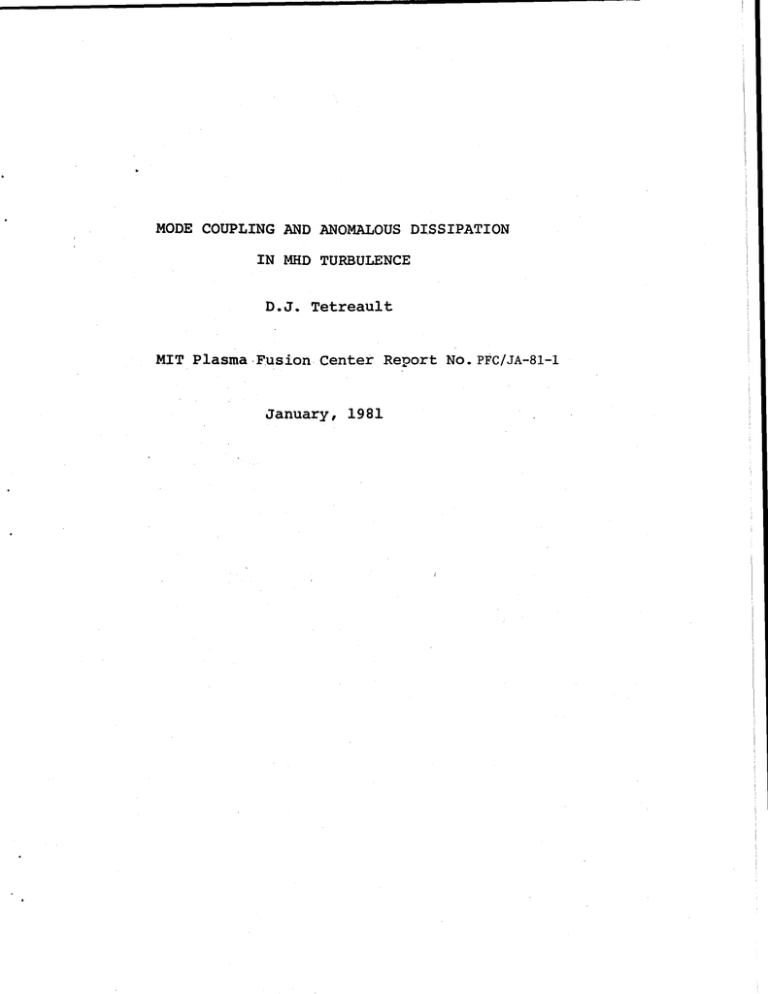
MODE COUPLING AND ANOMALOUS DISSIPATION
IN MHD TURBULENCE
D.J. Tetreault
MIT Plasma Fusion Center Report No. PFC/JA-81-1
January, 1981
i
ABSTRACT
An energy conserving model of MHD turbulence is described
that predicts both mode coupling and turbulent dissipation.
The dissipation takes the form of anomalous resistivity and
viscosity due to turbulent magnetic fields.
The model pre-
dicts a dual- cascade of energy to large wave numbers and magnetic flux to small wave numbers.
Turbulent rearrangement of
equilibrium magnetic shear gene rates resonant fluctuations
via a mixing length process.
The effect of tearing mode turbu-
lence on the disruptive~ instability in tokamaks is discussed.
A.
INTRODUCTION
Recently there has been much interest in the importance
of turbulent magnetic field fluctuations to fusion plasmas.
Theoretical investigations have focused on magnetic field line
stochasticity in space (173)
drift wave (4)
as well as its effects on finite-8
resistive interchange (5)
,
stabilities (6)
in laboratory plasmas.
,
and disruptive in-
It has been suggested
that turbulent magnetic field line reconnection may be important
to such varied phenomena as solar flares
tail
.,
,
the earth's magneto-
and the disruptive instability in tokamaks. (9,10)
Computer studies have been particularly useful in revealing
the dynamics of turbulent MHD phenomena.
The dual cascade of
energy to large wave-numbers and vector potential (magnetic
flux) to small wave numbers has been observed for the two dimensional case
.
This cascade has also been observed in three
dimensional, magnetic shear-driven tearing mode turbulence(1 0 )
In this latter case, the mode coupling proceeds after the overlap of two low mode number magnetic islands.
The production of
many modes leads to a "fully developed" turbulent state characterized by anomalous dissipation.9 r1
)
It seems plausible
that this anomalous dissipation is responsible for the nonlinear
(exponential)
growth
of the low mode number tearing modes
observed during this turbulent phase. (9,10)
We report here on an investigation of the turbulence described by the resistive MHD equations.
Our purpose i-s to
apply some established concepts of Vlasov turbulence
- 2 -
to the problem of turbulent MHD. Because of the mathematical complexity of. the equations, we have emphasized the physics that we
believe to be essential to any final theory.
Our main result is
a self-consistent, energy conserving model that predicts both mode
coupling
the
and turbulent dissipation.
The dissipation takes
form of anomalous resistivity and viscosity due to the turbu-
lent magnetic fields.
produced via a
modes.
Large wave number energy fluctuations are
nixing length process from the small wavenumber
This is a resonant mode coupling process that is similar
to the production of clumps in Vlasov turbulence. (12)
The paper is organized as follows.
Section B deals with the
energy conservation and symmetry properties of the MHD equations.
It is shown in Section C how the two point correlation function
is' a useful quantity to describe the conservation aid symmetry properties of two dimensional MHD turbulence.
In Section D we consider
the case of three dimensional turbulence driven by magneticshear.
The mixing length model is discussed in Section E.
The
effects of turbulent resistivity and viscosity on tearing mode
growth are discussed in Section F.
In Section G, the diffusion
equations describing the correlation functions are derived.
B.
Conservation Laws
The resistive MHD equations provide a fluid description of
the self-consistent magnetic and velocity fields of a tokamak
plasma.
(13)
Self-consistency is achieved by combining Ampere's
Law with momentum balance, and using Faraday's Law in conjunction
with Ohm's law to obtain
-32
=
+( V)
B'VB
V Cp+ -1
-
(la)
+2
(
at
+ V-V)B
Here, V and B
B- V +
4-7T
;
(lb)
are components of fluid flow velocity and magnetic
field perpendicular to the z direction.
The total magnetic field
is B = B z + B where B is assumed constant.
z
=V'
z
in Eq. (1).! are resistivity (n),
sity (p),
and the speed of light
Other quantities
scalar pressure (p), mass den(c).
Below we will find it
useful to use normalized variables, where resistivity is normalized
to an average value n, lengths are in units of minor radius a,
time is in units of the resistive time TR=4TA2/c2Yr, and magnetic
field is in units of B
(
.
a
S 2B-VB Vp*
+V*V)V
+ V-V)B
where S=TR'H and TH
In Eqn. (2a),
p+B 2/81.1
Then Eqn. (1) becomes
=
BVV +
(2a)
2B
-1/2
2
a(B z/4p)
is the Alfven
(2b)
time.
p* is the normalized value of the total pressure
Equation. (2b) -satisfies V-B =0 automatically.
We
impose V-v =0 on Eq. (.2a) so that p* is a known functional of
B
and V.
- 4 -
Equation ( 2). embodies several conservation properties of
physical significance.
Defining the poloidal flux,
BB = V$ xz and the velocity stream function,
V, through
, through V a Vx2,
Eqn. (2b) can be written as
+t
-
(3)
The nonlinear term in Eq. (3)
in Eq. (2b)
generates the BV. and V-V terms
Since the V-V term in Eqn. .(3 ) conserves poloidal
flux, it is a mode coupling effect on $.
However, this nonlinear
term is both mode coupling and dissipation in Eq, (3).
To see
this, we derive the energy conservation theorem from Eqn. ( 2)
and find
-
[<B
S
V >
-,T<j2 2>
4
where <> denotes an ensemble average and Jz = VxB
density.
In the derivation of Eqn. (4.),
is the current
the V-V terms vanish
separately (i.e., a mode coupling effect), whereas the B-V terms
cancel betiween Eqn. (2a) and Eqn. (2b).
This latter cancella-
tion is due to conversion of magnetic (velocity flow) energy into
velocity flow (magnetic) energy (i.e., a dissipation effect).
Because of the symmetry of the self-consistent Eqn. (2),
the cross helicity <B-V> is also conserved
-
- 5 -
a <B
V;> =-nUJ>
(5)
A
In Eqn. (.5 ) the B*V terms
where Uz = VxV is the vorticity.
vanish separately (i.e., a mode coupling effect)
whereas the
VV terms cancel between Eqn. (2a) and Eqn. (2b) (i.e., a dissipation effect).
An interesting form of Eqn. (2 ) that manifestly shows the
symmetry that results from self-consistency is
at
+ (SB +V)*V} (V -SB
-
)
(6)
-ISV
2
V P*
B
This form eliminates the dissipation effect explicitly and thus
conserves <(V-SB )2> by mode coupling.
A simple example of these conservation and symmetry properties of the self-consistent case is that of Alfven waves.. When
V p* = O .and n is neglected, the linearized form of Eqn. (2 )
gives perturbations 6V and 6B
that satisfy
2 a2
a
a2
(V,
at
SB 1 )
B
2 S2
.J2dVj,
La
(7)
az
where the Alfven speed is VA =-Sa/TR.
The symmetrical behavior
- 6 -
of 6B and 6V give the equipartition property of Alfven waves,
i.e., 6B 2 = S-2 6V 2 .
The "plucked string" analogy for Alfven waves
follows from the balance between the B'V B
restoring force of
the magnetic field lines in Eqn. (2a) and the B*VV frozen-in
property of the velocity flow in Eqn. (2b).
This balance con-
verts magnetic and flow energy into each other to satisfy energy
conservation and produce equipartition.
In this paper we are interested in the nonlinear effects
of Eqn. (2 ) due to a turbulent spectrum of self-consistent
6B and 6V fluctuations.
Any model that approximates the non-
linear terms in Eqn. (2.)
must retain the symmetry and conservation
properties of these terms.
In particular the two different effects
of mode coupling and dissipation must be distinguished.
We show
below that this distinction can be achieved by considering the correlation functions of B
and V.
The time evolution of the cor-
relation function is a physically appealing way to describe the
cascade of fluctuation energy to different spacial scales during
the mode 6oupling process
.1-)Having
treated the mode coupl-
ing in this way, the symmetry and conservation properties of Eqn.
(2 ) are satisfied in a natural way.
C.
Two Dimensional Turbulence
The equations for the correlation functions are derived in
Section G.
Here and in the next sections we preview some of
their consequences.
First we consider the case of two dimensional,
-
7
homogeneous turbulence where the correlation functions depend
only on r _ =r
- r2 .
For simplicity we treat the case where
the cross helicity is zero.
Retention of the -V-B > cross terms
is straight forward and leads to equations that preserve the helicity.
We also surpress n and p* for brevity and
attention on the nonlinear convection terms.
for simplicity that <B >
0.
and <V(rl,t).-V(r2 ,t)> as <B -
focus our
Also we assume
Then, denoting <B (L ,t)-B (r2 ,t)>
2>
-
and
2
> respectively, we
find that
at!U-
-
V -D -V
2S 2 V
B
.R2>
=-2V -DB -V <
--=12-- -l-2
at
--
- -
2
1- 2
B
=-2S 4 V -DBV
-12 --
(8)
<B *B >
-1 -2
(9)
where V_ denotes a derivative with respect to r , i.e. 3/ar_.
Here, D
(r
-
)
-
2 [D
-.
-
D
(
12~
)]
describes the relative diffusion
- 8 -
of two fluid elements.
14
)
The quantity D
2
describes the cor-
related diffusion of two fluid elements and has the property
that
(r
+ Dv asr+0
(10)
This occurs because two fluid elements that are close together
experience the same forces and, therefore, diffuse together
Conversely, if L is the size of the largest spacial
(D V +0).
scale, then
D2
-r
+
as r
(11)
+L
so that the two fluid elements diffuse independently
(DV
2D
Similar statements can be made for the magnetic field line
diffusion coefficients DB and DB
=12=The separate vanishing of the ViV terms in Eqn. (4 ) for
the mode coupling of energy is represented in the correlation
function equations by
.
Property (10) ensures that the V-
nonlinear terms conserve energy by mode coupling in Eqn. (8)
The dissipation of energy by the B-V terms in
and Eqn. (9).
is. represented in the correlation function equations
Eqn. (2)
by the DB and DB
-
=12
terms.
In Eqn. (8 1 the DB term is an
anomalous resistivity driven by the self-consistent, stochastic
magnetic fields.
It is an anomalous viscosity in Eqn. ( 9).
)
-
B
B
-Along with the D
9 -
terms, the D
terms describe the dissipation
(conversion) of magnetic and fluid flow energy into each other.
Adding Eqn.
(8 ) and ( 9 )
and noting that DB
= 2[DB -D 1 2 ] we find
that
{--V_at
(12)
} E =0
B
+ S2 B]
[
-
2>is the total energy correla-
where E(r_,t)
<B - 2> + S-2
tion function.
Property (10) ensures that the total energy
is conserved in Eqn. (12).
In forming Eqn. (12) we see that the
dissipation of magnetic energy by D
in Eqn. (8 ) is a source
B.
for fluid flow energy through D 1 2 in Eqn.
(9 ); and the dissipa-
in Eqn. ( 9)
tion of fluid flow energy by DB
B
12 in Eqn. (8).
magnetic energy through
- energy dynamics of Eqn.
Property
is a source of
This is just the
(2).
(11) implies that the predominant effect of the
nonlinear terms on the large spacial scales is dissipation.
ever,
for small scales,
D
energy.
, so that there are sources as
The nonlinear terms on the right hand
-well as sinks of energy.
side of Eqn. ( 8)
B
and ( 9)
are incoherent sources of fluctuation
Viewed as negative diffusion operators in r-,
energy up at small r_.
How-
they pile
These considerations imply that the
energy flows from large to small scales.
This! property can be
-
10 -
seen in a more quantitative way by considering the mode coupl(14)
described by Eqn. (121. Property (10) ensures
ing process
However, for
that the total energy E(o,t) is constant in time.
r_>0 there will be a diffusion in E(_) -to large r_.
Also, the
relative diffusion process preserves the area under E(__,t) i.e.
(D/ t)fdrE(r ,t)= 0.
Therefore, the spreading of E(r_,t) to
larger _ with time must be accompanied by a peaking of E(r ,t)
for small r
so that' the area is preserved.
Hence,
as time
elapses, the total energy is deposited into small (r)
scales.
The spreading of E(r ,t) to large r_ produces small wave number
(k) components to the spectrum.
2
-2
2
Since <B > = (27r)
fdk k
the poloidal flux flows to large scales.
$k
12
This cascade pro-
cess, as well as its analogy to two dimensional Navier-Stokes
turbulence is well known. (15)
Intuitively, the flow of magnetic energy from large to
small scales can be seen as follows:
B
the D terms in Eqn. (8)
and (9 ) follow from the nonlinear tension of the magnetic field
lines. -The anomalous resistivity is due to this random selfconsistent magnetic field line restoring force.
The bending
and twisting of a large scale magnetic field line generates a
small scale fluctuation in the field line and requires energy
to overcome the field line tension.
Therefore, the magnetic
energy must flow to the smaller spacial scale.
-
We note that the Eqn.
11 -
( 8 ) and ( 9)
appear' to violate the
time reversibility and nondissipative nature of the MHD Eqn.
(2 ) for n = 0.
However,
Eqn.
(.8 ) and ( 9 ) describe the en-
semble average, statistical properties of a system whose microstate
equations are Eqn.
(2) with Tr = 0.
An analogous situation occurs
with the Vlasov equation, which is also time reversible and nondissipative.
However, quasilinear theory introduces inversibility
and dissipation.
The diffusion coefficients in Eqn. (8) and (9) are fluid-like,
i.e. nonresonant.
For instance, the velocity diffusion coeffic-
ients can be written approximately as( 1 4 )
(.2r)~(2'k:
-2fdk <V
-2N
V *>
~' T (k)
(13)
-2~
Dv
where
(27)-2fdkk)
(1-cosk-r )
is the Fourier component of V and TN (k) is the cor-
relation time of a velocity fluctuation with scale k
tion G we point out that
ance of D
=-
in T
N(k)
T
-1
2
v
(k)~k-D (k k ),k,]
-l
.
In Sec-
The occur
rather than Dv ensures that, while the
small scales can dissipate the larger scales, the large scales
cannot dissipate the smaller scales.
This property is known as
-
Galilean
12 -
Invariance. (14)
The Galilean
Invariance property implies that, as far
as the small scale fluctuations are concerned, a large scale
fluctuation can be treated as a near spacially uniform back-
ground field.
If the large k fluctuations have amplitudes
smaller than the small k fluctuations, then perturbation theory
is valid for the large k components.
Consequently, the large
k componets will behave like Alfven waves. (16)
We expect
equipartition of energy for the large k components of the spectrum.
These considerations allow an estimate to be made on the
relative importance of p* in the correlation equations.
compressibility in Eqn. (2a) gives p*S
2
(6B2-6v).
term is small on the right hand side of Eqn. ( 9)
Sr-2 (6B)
2D
from Eqn.
(13),
> 6 Vr
p*,
or SD 2/r
B >
(S
6B
In-
The p*
if
6V )/S 2 6B.
But
Dv~r_6V.r 6B, so that p* is negligible if
[S ( B_) 2-(6V) 2U
2
(6BL) 2 <l
is approximately satisfied.
i.e., if equipartition of energy
We note that this condition is
important to the energy flow discussed above.
In particular,
if the magnetic perturbations were set equal to zero, Eqn. (9)'
would reduce to the case of two dimensional Navier-Stokes turbulence.
<6V 2>,
One could not conclude, however, that the energy,
flows to small scales as before.
The reason is that p*
- 13 -
2
is not negligible in this case, i.e. p*~(6V)
D.
Driven Three Dimensional Turbulence
An equilibrium magnetic field- with shear alters the spac-
ially homogeneous case described by Eqn. (12) in two important
ways.
The mode coupling becomes resonant and the turbulent
fluctuations are driven by the free energy source of the
magnetic field gradient.
The effects of magnetic shear are most clearly seen by
considering Eqn. (6).
In Section G, we derive the governing
equation for the correlation function <(B -S
1
1 )(B
2
We consider helicity-free tearing mode turbulence where
2 )>.
4
and
have-opposite" parity for an individual tearing mode
De-
fining 6B,= B -<B > and 6V = V - <V>= V, then 6E(rt)
> + S<V
<6B
> satisfies
+ S(.B_ >
+ <B>V)
S 2 VID
whereD
DB + S - 2D
-
-
and
ad=
+ D2 1
1 22
S 2 V_-
2
-+B
} 6E
(15)
2
. =122 + SD-2 =12'
When magnetic shear causes <B>-V to vanish at a mode
- 14 -
rational surface, the correlation function in Egn. (15) becomes singular for weak fields.
The fluctuations produced by
the mode coupling are thus resonant at the mode rational surfaces.
For finite amplitude fields, this resonance is
broadened by the. dissipation S2 D.
In Section G, it is shown
that the diffusion coefficient is also resonant in the presence of magnetic shear, and for weak fields, can be written
as
D =S -1
dk
(2
2
2<b >
k
7r6(k
-k
z
<B >'x)
y_
(16)
y
where <B >
3<B >/3x is the gradient of the average poloidal
y
y
magnetic field, x is the position of the mode rational surface,
2
2
-2
2
<b > = <_B>
+ S <6V2 > , and fdk = fdk fdky.
For finite
amplitude fields, the resonance in Eqn. (16) becomes broadened
by the effect of S2 D in Eqn. (15) so that
D
xx = (270r)
-2
2
fdk<b >
-xk
R(k
z
-
k <B >'x)
(17)
'y
where
R(X)
f
dt exp[isxt -,'-S
0
Equation (17)
(k <B >') D t
xx
yy
]
(18)
implies that a magnetic field line will
-
15
-
resonate and diffuse if it is within xd of a mode rational surface, where
xd
S D
3k <B>
y y
1/3
(19)
This is also the width of the correlation function of a large
spacial scale, since, from Eqn. (15) , 6E peaks for
Sx-k <B >is
S2 D
2X/X9
It is interesting to note that Egn. (15) retains its
form under the redefinition St-t and SD+D. Then, for the time
stationary case, Eqn. (15) is independent of S and time, and can
be interpreted-as .describing the diffusion of the field lines in
x as one moves along z.
brium". (3
This describes a "stochastic equili-
Relaxing the condition 3/Dt=O allows the mode coupl-
ing to occur in the regions where k*<B>=O.
We show below that
this mode coupling rate is exceedingly fast and raises the question as to whether a stochastic equilibrium is possible.
The physics described by Eqn. (15) -(17)
more intuitive by writing D
D
can be made
as
xx
~<br2>
td
x res
d
td=
d
[(k <B >)
3y
y
(20)
where
2 S 4 Dxx] l-/3
x
(21)
2
Here, <b xres
>
is composed by those fluctuations whose resonance
- 16 -
widths are within xd of x, and is defined as the resonant portion of the spectrum.
D
<b2 >
3
4
Combining Eqn. (20) and Eqn. (21) gives
1/2. S 1
(k <B >)
so that Xd and td can be writ-
ten as
21/2
xd
k
(22)
xres
<B'
y
y
and
S
t-1
d
First,
we note that,
2 1/4
x res
k <B >')
y
y
/223)
in the limit of one resonant fluctuation,
Eqn. (22) is the usual expression for the magnetic island
width.
In the turbulent--many fluctuation--case, the re-
sonance broadening of Eqn. (17) allows modes adjacent -to the
mode rational surface. to contribute to the resonance
width xd
and to the diffusion D
.
Therefore, D
when two magnetic islands overlap.
will become nonzero
Subsequent to this, a
nonzero D'. in Eqn. (15) will cause mode coupling and dissipax
2 -1 time scale. In this turbulent
tion on the td IS22D/xd 2
phase,. Eqn. (16) is a valid expression for D
, since the over-
lap criteria will be satisfied throughout the spectrum.
- 17 -
E.
Mixing Length Model
The nonlinear term on the right hand side of Eqn. .(15) is
the shear-driven, free energy source for fluctuation energy.
It is an incoherent
(12)
source of fluctuation energy due to
the mixing of the average magnetic field gradient by the dif-
fusion process.
Because of properties (10) and (11) the in-
coherent source in Eqn.
k) fluctuations.
(15) mainly drives small scale (large
This is consistent with the mode coupling
process where energy flows from large to small scales.
The p* term neglected on the right hand side of Eqn.
is small if SDB <B
[S 2(6B)
2
(15)
> <p*Xd 6V> which gives
2-(6V) ]/S2 (6BL)
parameters (6 BL/<B±> <10
-2
6B
<(xd/<B>) (<By)
>
For reasonable
-O2
), the p* term is neg-
and xd
ligible if equipartition is approximately satisfied.
Hence,
for the large k components of the field, the shear driving term
dominates the right hand side of Eqn.
validity of a "mixing length" model.
(15).
1 4 ,1 9
This ensures the
The large k fluc-
)
tuations are created by the turbulent rearrangement (mixing) of
the small k field components on a scale 6x.
6E~<b >
x
-
<(6x) 2>(9<B >/ax) 2
Then
SD ( <B1 >/ x)
where T
is the mixing time that follows from inverting the left hand
side of Eqn. (15).
The spacial scale of these modes and their rate of pro-
duction can be seen in a physically appealing way by an approx-
-
imate inversion of Eqn. (15).
2
2 TDx(<B
<b>~S
18 -
In the resonant region
2
L>/@x) 2 becomes (C6$/ax)
2
S TLk 6)
2
2
T_(<B>/x)
so that t_~[Sk x <B >']
.
But from the resonance condition
y
yfor 6E (x<xd) and Egn. (19) we find that T td where td is
given by Eqn. (21).
Therefore, the scales xd and td charac-
terize the incoherent fluctuations driven by the shear.
This mixing length model is analogous to the mixing
length model of Navier-Stokes turbulence.
(14)
There, the
turbulence produces an eddy viscosity that mixes up the large
spacial scale velocity shear to create incoherent turbulent fluctuations.
In the MHD case presented here, the magnetic field
turbulence produces a turbulent resistivity that "tears" up
the large spacial scale magnetic shear to create incoherent
turbulent fluctuations.
We suggest that the mixing length model may desscribe the tearing mode turbulence that is thought to be
responsible for some disruptions in tokamaks.(13)
puter simulations study
..
During com-
of the disruption,.the plasma cur-
rent profile develops small spacial scale fluctuations at
the mode rational surfaces and expands radially outward to
induce a drop in the plasma loop voltage
spike").
Eqn. (15).
("negative voltage
This phenomena is consistent with that predicted by
The magnetic shear is the source of free energy
that drives the mode coupling process at the mode rational
-
surfaces.
19 -
The turbulent diffusion mixes regions 'of large and
small poloidal field.
Since B<B 1 >/3x<O, there is a net trans-
fer of current density radially outward.
The phenomena of resonant mixing occurs also in Vlasov
turbulence.(12)
There, "clumps" of phase space density, f,
are produced by the turb;ulence at the wave-particle resonance,
because, from the Vlasov equation,
at
+ v
az
+
f is singular at w)
ez
(24)
mza
k v for weak electric fields Ez.
These
resonant modes are not normal modes of the system, but are more
like ballistic modes.
The spacial modulations produced at
these resonances are due to a.resonant mode coupling process.
In the MHD turbulence model presented here, magnetic
shear allows a resonant, ballistic-like mode to exist.
As in
the Vlasov case, this mode is not a normal mode of the system--
such as a tearing mode--but is an incoherent, resonant fluctuation produced by the turbulence.
This resonance can be seen
from Eqn. (6 ) where it is evident that -when w=
kk
=
k <B >'(X -x) is satisfied, singular fluctuations develop.
0
y y
We suggest that these incoherent, resonant modes cause the
"clumping"
and radial expansion of the plasma current during
- 20 -
computer simulation studies of-the disruptive instability.
F.
Nonlinear Tearing Mode Growth
In Section C it was shown that the predominant effect
of the nonlinear terms in Eqn. (.2)
was anomalous dissipation.
for a large spacial scale
Here we outline the effects of
anomalous resistivity and viscosity on tearing mode growth.
We expect that the nonlinear terms in Eqn. .2 ) for a large
spacial scale can be represented by S 2
xx
.
To. derive this
from the one point equations, we neglect the mode coupling
V-V terms and approximate the B-V terms as pure diffusion (dissipation).
Again, this. is only valid for the large scales, since
the small scales have sources as well as sinks (dissipation).
Fourier transforming Eqn. (2) in y and t gives
-icV
S2 E B ,
Ic Ma
Bk
+ S 2 ik B
ku'+S
+ S2B
I
ka
B >
y
(25a)
-iB
where k=
kz - k
=
B k, a
<B >'x.
Vkk, + ik V
+
2
2 Bk
Because of Galilean
(25b)
Invariance,
we include only _1k>k in the k' sums of Egn. C25).
ing the perturbations in the nonlinear terms gives
Then, iterat-
-iV
= S2
D ZB 2
-
21 -
i
9
2
+ iS k B
V
+ S2B
-iwB
B2
k
B
Xk-
+ ik V
Xi-
k ax
<B >
y
(26a)
+ ri 2 Bk
ax
(26b)
-
Since we are interested in the turbulent effects of the inco-
herent, resonant k' fluctuations on the mode k, we set
W' = kz -
k' <B >'x
y
in Eqn.
y
(26).
(Note'that this is the re-
sonant-mode coupling rate since w = k <B >'(x - x)
0.
y y
-1
k <B >'x = t
).
The large scale fluctuations thus satisfy
y y
d
d
t
6V
-
x
-2
D
-6V
xxax
+S
<B>*V6B
2
+ S 6SB *V<B >
at
where D
6B
-- Li
D
(
+ S Dxx )
is given by Eqn.
aX-
(27a)
B + <B>*V6V
(27b)
(16).
For finite amplitude fields, the nonlinear resonance in
Eqn. ( 6) will. broaden the k' modes in Egn.
S2D
xx so that D x
in Eqn.
(27)
by
(27) will be given by Eqn.
(17).
- 22 -
Taking the z component of the "inverse curl" of Eqn. (27a) and
the curl of Eqn. (27b) gives
s-2
-
32
2Dm6U
aaU
a
a6
<B>-763+ 6B
ax.
(28a)
a
2
(TI
V<J>
+ S2D
)92 2 6$
ax
-
<B>'-V6
(28b)
Displaying the shear terms explicitly in the resonant region
gives
tI
(
atk-
+ S2D
D
U
-
x
k <B >'(x-x 0 )4
y y
0k
atkxaX
y
k
2
2b
)a
<B >' (X-X
-k
U
a
(29a)
a2
2
=
S-2
)
0
(29b)
X2 Vk
in the resonant region Ix-xOI<xd, the nonlinear terms dominate
2
the linear terms.
For S2D
>
a small k tearing mode will grow
at the rate
YNL ~S 2D
(30)
xd
where A' is the usual tearing mode stability parameter.
We note that this is of the same form as the linear growth
rate:
d replaces the tearing layer width, and S D
replaces
-
23 -
the collisional resistivity.
It is interesting to compare the physics of the growth
described here with that of Rutherford's nonlinear theory
of one mode.
We integrate Eqn. (29) over the resonant
region to obtain
i(xO)
Xd
2(+S
(31)
In the Rutherford .case of one mode, we've shown in Section D
that x d reduces to the expression for the island width for
k.
Hence, Eqn. (31) would lead to the algebraic growth with
time of the Rutherford theory.
However, after island overlap
and the production of many modes, xd would be only weakly dependent on the mode l .
Then xd would be due to the many
k' -that are within resonance with v
and would be a number
characteristic of the turbulence through -D
(see Eqn. (19)).
xx
For S 2D >n, then Eqn. (31) leads to the exponential growth
rate of Eqn. (30).
This transition from algebraic to exponen-
tial growth after island overlap is an important consequence of
the turbulent state.
The scaling of the growth rate yNL is of interest.,
Since
the anomalous resistivity is normalized to the average resis2
is an effective Reynolds number
tivity nI, then R E S D
xx
m
I
-
24 -
characterizing. the turbulence.
We, therefore, write
2/3
1/3
YNL
(32)
y<B >
For the early stages of the turbulent process (Rm-1)
YNL~S
1/3
.
as
In present day tokamaks, S410 7 so that YNL
.then
2/5
which scales like the linear growth rate, Y2/1 , of the ."2/1"
mode. C3,l7)
[k <B >']
For reasonable parameters (S1-107 , Rm>l,
~2 sec), Egn.
l, A'~1,
(32) implies a time scale
< 900 Psec.
However, during the fully turbulent phase (R >l) ,Y
~m
N
is sensitive to variations in R .
From Eqn. (30) we see that
m
NL(S D
2
YNL_
xxx
only on TH.
S
~S<b >res.
e'N
Thus, YL in "real" units depends
Therefore, in the Rm>l phase, YNL is greater than
and is independent of resistivity n.
We have argued in Section
C that the turbulent deflec-
tion of magnetic field lines from unperturbed flux surfaces leads
to anomalous resistivity and perpendicular viscosity.
Here
we show how the deflection of pressure surfaces leads to anomalous parallel viscosity.
Transfer of parallel momentum occurs in the fluid equations
via perturbations in pressure surfaces.
We note that the elec-
tron parallel momentum balance, expressed in real units, is
B <n > eE
z
e
T B-Vn
z =7e-- e
(33)
where Te is the electron temperature, ne is the electron particle
density, e is the electric charge, E
is the parallel electric field,
-
25 -
and we've assumed that the electron pressure is n eT
.
Magnetic
fluctuations will cause deflections in the pressure surfaces
in Eqn. (33).
cosity results.
If the deflections are random, a parallel visTo show this, we note that in the tearing mode
the ion density responds to the polarization drift
(47re)
n
1 c2 V
-2
(34)
2
Using quasi-neutrality, Eqn. (.33) gives
E
2 2c2
(B - V)
D
2(B-V)U
A
z
(35)
where all are quantities are normalized (see Section B) and A
D
is the debeye length normalized to the minor radius.
Equa-
tion (35) adds a correction to Faraday's Law (Egn. (28a))
a2
2
(+SD
2
c2
B VU(36)
-B-V
A
Using the curl of Egn. (.2a) to renormalize the B-VSU term in
Eqn. (36) as-was done at. the beginning of this section, we find
that Ecjn.
(36) becomes
2
at
(I+
Dx
J-
B-V
-
plvi(37)
-
26 -
2
where the anomalous parallel viscosity p= .
i D
.-
2 B
2B
S
2*
xx
.
Con-
verting this to "real" units, we define the elettron thermal
velocity V 2= T /m
so that
+
4 e1 e
4-r1=
aR
and the plasma frequency wi
2
~2
(A) "where1
~
V
= Ve
A
= 41rn e 2/me
e D )P. Here D m =aSDB
is the stochastic magne ic field diffusion coefficient.(3)
anomalous parallel viscosity i =V eDm has been suggested
as a cause of disruptive instability in tokamaks.
An
(20)
Our result
differs by the factor Ve/VA from the suggested value.
This
difference is due to frequency response of the current fluctuations.
In the model presented here, the electron fluid re-
sponds on the Alfven time scale.
However, in the model of Kaw,
et. al the field lines are fixed in time (but are stochastic
in spice) and the electrons respond on the R/Ve time scaie.
From Eqn. (37) the ratio of anomalous viscosity to anomalous
resistivity effect is *2ps 2 where ps is the ion gyro radius at
the electron temperature.
here break down when k
G.
We note that the fluid equations used
2 >
Derivation of the Diffusion Equations
In deriving the diffusion equations, we follow Reference
14.
We consider Eqn. (15) first, and define L ;B-B
N = B + VS
-1 so
{
that
follows from Eqn.
_-2
+ SN 1
1
+ SN 2
2
1
2
S- V,
( 6)
(38)
-
.
27 -
Since we are interested here in the nonlinear terms on the
left hand side of Eqn. ( 6), we have surpressed the
terms in Eqn. (38).
and p*
We define
L - -22 ==
N
n
L'
2> +
l
=
<N> +
(39)
1> 2
(40)
SN
where 6 denotes a fluctuation about the average.. We now average Eqn. (38) and use Eqn. (39) and (40) to obtain
{
+ S<N >-
+
-ati
-<~
2 >
2
+ S E V <6N 6(-i=l,21
1(LL)
k 12 >
-21
(41)
=.
Next, we substitute Eqn. (39) and (40) into Eqn. (38) and sub-tract Eqn. (41) to obtain
{
+ S<N
=-
>-V + S<N >V
-2 -2
- l
=-S6NV
+S
1
E
iml,2
L =2
-L2
-
+ %N2 V ] <L L 2>
'< 6N .6(L - 2_ >
(42)
- 28 -
In the Markovian approximation, we neglect the last term,on
the right hand side of Eqn. (42).
This allows us to obtain
a diffusion equation for <k IL2 >. (14)
With this approximation,
we integrate Eqn. (42) to find the response of 6 L-L
2
=-Sf dT G1 2 (t,T)
o
6Nr ,t) V.
a=,2
x
where the propagator
{
-
G
SN -V
and G 1 2 (tt)= 1.
1 -+l
2)
-
(T)>(43)
satisfies
+SN(44
S-2
2
}G
2
(44)
(tlT) = 0
If we now substitute the expression 6
of Eqn. (43) into Eqn. (41) we obtain
at + S
E<NE.>V
i=1,2
-
-D
}
ij=12'
x<E *2>
0
(45)
where
D
=13
=
f dT <6N(r.,t)G
0
1
2
(tT)6N(_ .,rT.>
12--
(46)
2
29
-
-
In arriving at Eqn. (45) we have set
in Eqn. (43) .
L1 (-)*
2 (t>
1
(t)'L
2 (.t)>
This is the usual Markovian approximation, and
is valid if the spectrum correlation time is short compared to
the relaxation time of <Lg-L2>
Following a similar procedure for the one point equation,
-< 2> satisfies
we see that
{
.
N.>-V.-S
1,2.212
S
-+
8t
2
V.-D( rr.) V.}
2<>
L
x
(47)
O
This equation also follows from Eqn. (45) where we put L=<
which we note diffuses independently of <
Now we subtract Eqn..(47) from: Eqn.
{
8t
<SN.>-.
i=l,2 ~
2 V11
-2S
where <6L-5L 2 >
i
L
L2 >
<
2 D.
3
i.=l,2
<1~
2D
1 >*
''
=D
1 2 O*
(45) to obtain
ZVS
-
2 >Ui
*~V.} <6L-L>
2
-1
(48)
<L2
2 >,
the fluctuation correla-
tion function, depends on the relative coordinate r
We assume that <V>
=0
icity-free case, <V-B>
so that <L>=
0.
>
N> = <B>.
2'-
In the hel-
We assume generally that <
1
'-2 >
- 30 -
is
<
<BB? and S
less. than
With these considera-
- 2>.
tions, Eqn. (48) reduces to Eqn. (15) of Section D.
The quantity G
by using Eqn. (44).
2
(.tr)6N(r ,t)
in Eqn.
(46)
can be evaluated
We write
D1
=ij
-ikr.
0-
gN1(k) e
fdt
D2r)dk
(21r)
2.
o
G12 t
T)>e
ik~r
r
(49)
where gN(k) is the Fourier transform of the spectral correlation function
gN(k)
=
fdr e
---
(50)
<6N(E,t)*6N( 2 't)>
We again make use of the Markovian approximation, so that the
cut-off of the T. integral in Eqn. (49) is due to the orbit correlation time of G
2
(t,-r)
rather than the relaxation of the
correlation function gN(k) . We, therefore, set T=t.in Eqn. (50).
Now, since <G 1 2 (t,T)> satisfies the same equation as
<!
(t)
L2(t)>
(i.e., Eqn. (45)), we can write.
+ SB2 >2
22
2
<G
0
e
(51)
In the presence of shear, the operator .in braces becomes
-
{f
at
+ SBz
SB
31 -
S Sx2<B
B'L>
Z
2
y
DY2
S 2 a 1D
X2 D
D
(()2 )La,
ax 2 )
(52)
where D.. (2) is the x 2 component of
D
kz
2
+ ky
2
2
we find that
-ik -r2
2
eG12 (t,T)>e-
e
exp[-iS(k -k x <B >
z
Then with kr
y2
y
)t -1/3
S
3
(k <B >)2 D
y y
xx (2)t
(53)
(3
With this expression in Eqn. (49) we can explicitly evaluate
.
In particular we see that D
xx is given by Eqn. (17) of
Section D. *For weak fields, D12 becomes
D.
2
fdk <bx>
2
Ck(kzxB >k )e
ik (y -y2)
(54)
where we've put k' (r-r
case x 1 x 2 .
Then
2)
=
k (y -y2 ) for the near resonance
-
D_ =(.27)
x
2
32 -
fJdk <b >k6.k
-x<B >k I
(l-cos k (y-y2)
(55)
is the x component of the relative diffusion coefficient
D=
2(D-D 1 2 ).
The correlation equation for the two dimensional, homogeneous case with no equilibrium field (i.e., Eqn. (12) of Section C)
follows from Eqn.
again that <V1-B2> is
helicity-free case.
(45)
if
we note that <N> = 0 and assume
less-than S<i!*B2 >and S l<H 1 'Y 2 > for the
The evaluation of D..
case is more difficult.
for the <N> =0
In the <N>3O case, there is a lbwest
order contribution to G(t,T) that is phase independent.
This
shear effect allows us to put G(t,T) = <G(t,T)> in writing
Eqn. (49).
In the <N> = 0 case, however, the lowest order
contribution to G(t,T) comes from the perturbations 6N, so
particular care must be taken in evaluating the phase aver-
age in Eqn. (46).
(see Ref. 14),
Although we don't present the details here
the expression corresponding to Eqn. (55)
can approximately be written as
D
1-cos k-r
2
-2 fdk<b 2>
2(2) k2
Sk-D_(.k/k2
(56)
k
so that now the fluctuation lifetime TN(k)'(k-D *iCV
1
plays the
- 33 -
role of td-
This
evident by comparing Eqn. (12) and (15).
is
(8 ) and (9)
The derivation of Eqn.
straightforward.
of Section C is
Consider first the V*V term in Eqn. (2a).
Proceeding as in the beginning of this section we see that
the V-V term generates V -DV .V_ in the equation for
<
1
-v2 >.
This can be done also by identifying SN-+V and L+V in Eqn. (38)
Similarly, the V-V term in Eqn. (2b) generates
and (45).
V _D V-
in the equation-for <B -12 >.
The B-V terms in Eqn.
C 8) and ( 9) are more interesting since they couple the two
equations and lead to the anomalous viscosity and resistivity.
Surpressing the V-V terms now, we write
-2-7
+ B-VVB
S-2a=BVVVB
-2
at -l -2
112
2-1
-2 -22 1
+
2 +
-'1-2
(57a)
-
-1- 2
(57b)
VV*
-22L1
(58a)
But
a VB
at -1 -2
2
2!
2-1
22
a
12
2B2
+
1
+ B
2
V-V
(58b)
-
Consider Egn. (57b).
in:. Eqn.
34 -
We expand the correlation functions
(58) . into
average and fluctuating parts.
We
then integrate to obtain
S(Y_*B2
S
0
fdTG 1 2 (t,T) B V
<B
2
+fdTG 12 (t,T) E2* L2< 1
(59).
2>
0
and a similar equation for 6(V
Eqn.
6(V 2
(58).
If
).
1
The operator G12 solves
we now substitute the expressons for
6(V
1
B-
2
)
and
) into Eqn. (57b) and average we find that
2t =12
2. 2
=SVD
<g
=1
2 2 =2.2 -2
.21
4-SS2 R 1
1
B
2
2
V
< -B->2
214
l~ly
B
*<B
V*D
B
<B
2
++ Y
-
12
2
-ll -2>
(60)
where
D.
B
F
dT<B
0
-i
(t) G
12
(t,T) B.CT)>
-
(61)
For the spacially homogeneous case, the correlation functions
-
35
-
depend only on r =r -r2 , so that Eqn.
of Section C.
(58) and averaging,
- _V
(8 )
reduces to Eqn.
In similar fashion, Eqn. ( 9) can be derived.
Moreover, by integrating Eqn. (57)
I
(.60)
_
and
we find that G
_DV
- 2SD2
B
.
2
inserting
in Eqn.
(t,T) satisfies
12
(tiT)> =
(.62)
-
36 -
ACKNOWLEDGEMENT
The author would like to thank B. Carreras and his.
co-workers at ORNL for sharing their computer
results.
simulation
Acknowledgement goes also to B. Carreras, T. Dupree,
J. Freidberg,
D. Montgomery, S. Olbert, and M. Rosenbluth
for useful conversations and criticisms.. This work was supported by the U.S. Department of Energy and the National
Science Foundation.
-
1.
A. Rechester, M. Rosenbluth, R. White, Phys. Rev.
Lett. 42, 1247
2.
37
(1979).
J. Krommes, R. Kleva, and C. Oberman, Plasma Physics
Laboratory, Princeton University Report No.
PPPL 1389, 1978.
3.
P. Diamond, T. Dupree, D. Tetreault, Phys. Rev. Lett.
45, 562 (.1980).
4.
K. Molvig, S. Hirshman, J. Whitson, Phys. Rev. Lett.
43, 582 (1979).
5.
W. Manheimer, Phys. Rev. Lett. 45, 1249 (1980).
6.
B. Carreras, M. Rosenbluth, H. Hicks, 1980 Sherwood
Theory Meeting, Paper 1B32.
7.
S. Kahler, D. Spicer, Y. Uchida, H. Zirin, Solar
Flares, ed. P. Sturrock, Colorado U. Press 1980,
Section 3.3.
8.
A. Galleev, Phys. Fluids 21, 1352 (1978).
9.
H. Hicks, J. Holmes, B. Carreras, D. Tetreault,
G. Berge, J. Freidberg, P. Politzer, D. Sherwell,
Brussels 1980 IAEA meeting.
10.
H. Hicks, B. Carreras, V. Lynch, Bull. Amer. Phys. Soc.
Nov. 1980, Paper 5Q6.
11.
D. Fyfe, G. Joyce, .D. Montgomery, J. Plas. Phys. 17,
317 (1977).
(1972).
12.
T. Dupree, Phys. Fluias 15, 334
13.
B. Waddell, B. Carreras, H.-Hicks, J. Holmes, Phys.
Fluids 22, 896 (1979).
14.
T. Dupree, Phys. Fluids 17, 100 (1974).
15.
D. Montgomery, L. Turner, G. Vahala, Phys. Fluids,
21, 757 (1978).
16.
R. Kraichnan, Phys. Fluids 8, 575, 1385
.19651.
-
38 -
Furth, J. Killeen, M. Rosenbluth, Phys.
6, 459 (.1963).
'luids,
17.
H.
18.
P. Rutherford, Phys. Fluids, 16, 1903 (1973).
19.
H. Tennekes, J. Lumley, 1972, A First Course in
Turbulence, MIT Press, Cambridge, Mass.
20.
P. Kaw, E . Valeo, P. Rutherford, Phys. Rev. Lett.
43, 1398 (1979).
